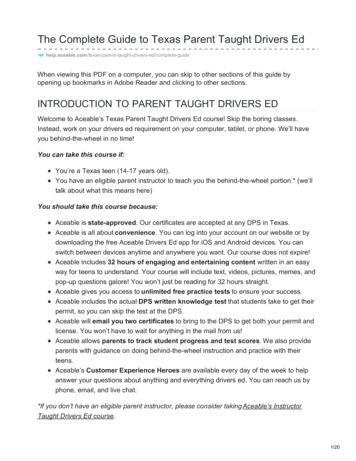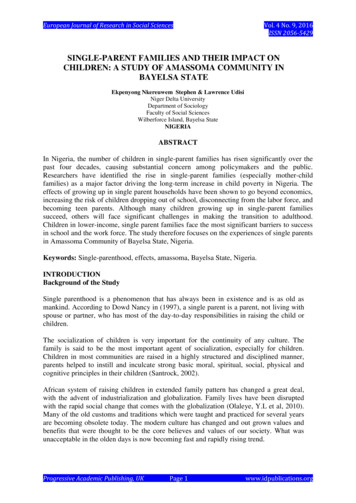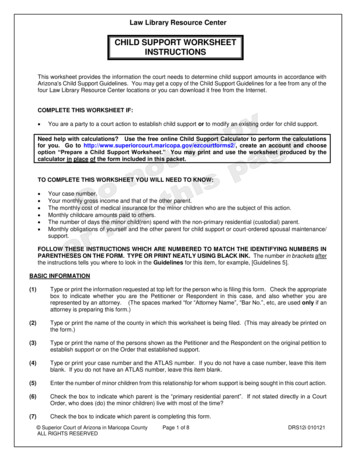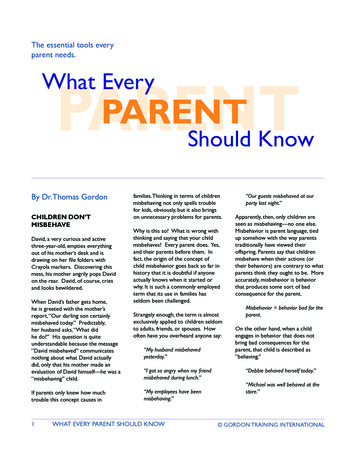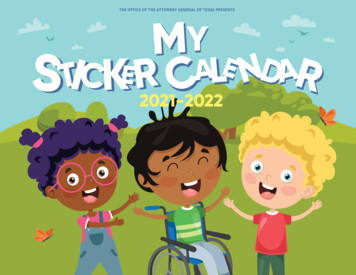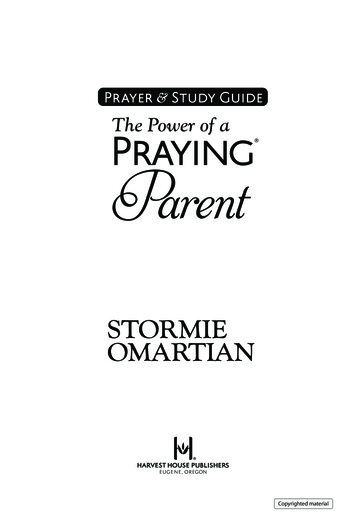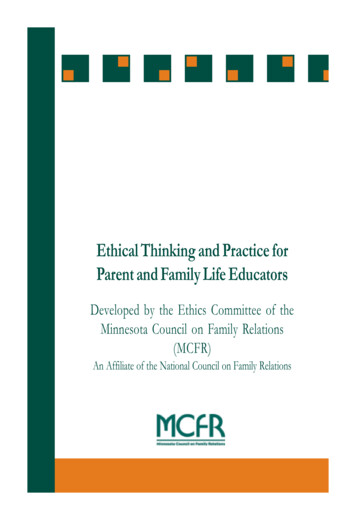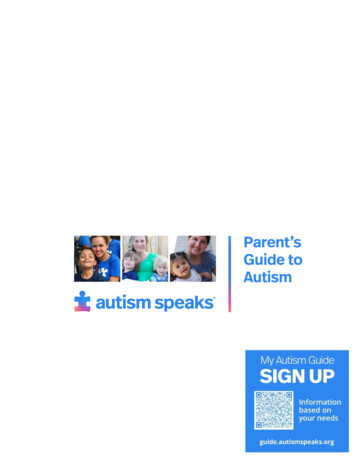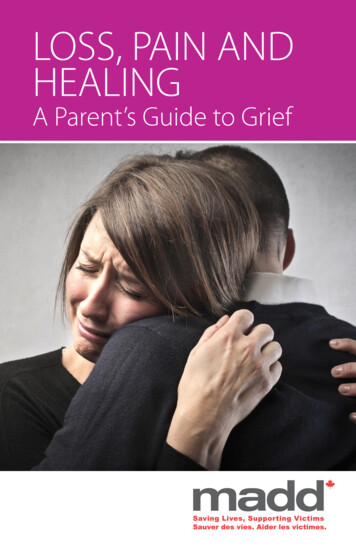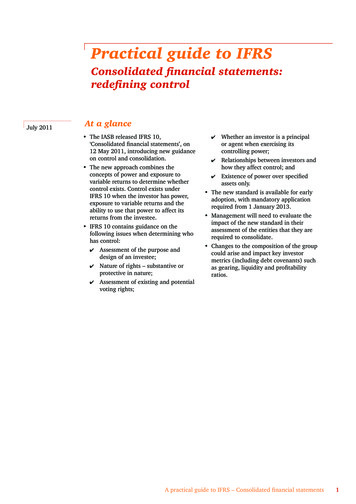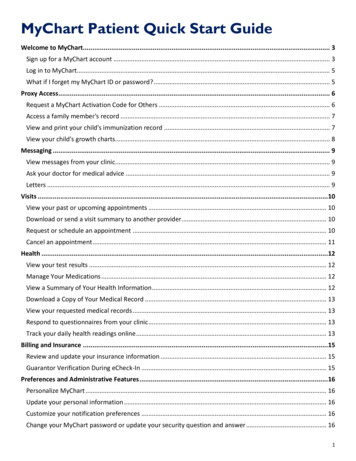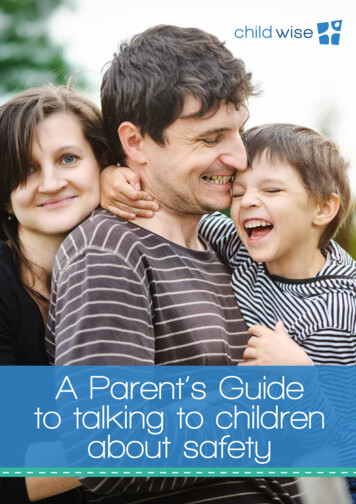
Transcription
A Parent’s Guideto talking to childrenabout safety
About Child WiseEstablished in 1991, Child Wise is one of Australia’s leading not-for-profit child sexual abuse prevention organisations. Ourvision is of a society in which children can grow up free from abuse and exploitation. Child Wise works to build awareness,deliver education, and provide the tools to empower individuals and communities around Australia so they can activelyprevent child abuse.Purpose of the Parent’s GuideThis booklet has been specifically written for parents and caregivers to assist you in talking to children about personal safety.As the primary protectors of children, parents and carers play an integral role in keeping children safe from harm. In order toprevent children from becoming victims of abuse, it’s important that they are armed with the knowledge and skills to identifyunsafe situations and to speak up if they ever have concerns.ISBN: 978-0-9577811-3-9 Child Wise Ltd, 2015.Design by Jasmine Tsan.Child Wise values feedback and comments in order to improve our programs. Please contact us if you would like to make any suggestionsregarding this guide.
ContentsIntroduction2Why speak with children about safety?3How to talk to children about safety44567The Safety ContinuumOpen communicationEarly warning signsOne step removedListen and act8Developing children’s safey network9Find out more10Child Protection contact details12
Page 02IntroductionChildren have the right to be and feel safe at all times. Talking tochildren from an early age about safety, their bodies, and how theycan protect themselves, is an important part of keeping them safe.Personal safety, also known as protective behaviours, is a powerfulway to teach children about safety, risk taking, and what they cando when they feel unsafe. Children who are confident, assertive andhave good support networks are less likely to be at risk of abuse orfind themselves in dangerous situations. By building awareness of'safe' behaviours, and teaching children empowerment strategies,protective behaviours aims to promote child resilience; andultimately reduce child abuse in our community.Parents andcarers can be highlyeffective instructorsin protectivebehaviours forchildren.To create child safe communities, parents and carers need to learn about the issue of child safetyand child abuse. The more knowledge parents have about child safety and child abuse, the greaterlikelihood they can create safe environments for children and prevent the occurrence of abuse or unsafesituations. Knowledgeable parents and carers can identify unsafe situations and potentially preventinteractions between their children and perpetrators of abuse. Learning the facts about abuse will alsohelp stop parents and carers from overreacting to situations that may not pose a risk for children’s safety.As parents and carers, you can be highly effective instructors in protective behaviours for children.Research shows that children who receive consistent safety messages, both at home and at school, aremore likely to be confident in responding to unsafe situations and to speak up if something happensthat concerns or upsets them.Child Wise acts as the Chair of the Protective Behaviours Victorian Reference Group, delivering a holisticapproach to protective behaviours. You can find out more about our work and Protective Behaviourseducation programs on the Child Wise website: www.childwise.org.au
Page 03Why speak with childrenabout safety? Most children are abused by someone they know and trust – making it harder for them to speak up. Creating a child friendly space (in the home and in organisations) helps children to speak up – andpersonal safety is a key component of this. Most children don’t speak about abuse that has happened to them. There were 272,980 notifications to child protection across Australia in the 2012/13 financial year.It is always the responsibility of adults to protect children and ensure they are kept safe from harm child abuse is never the child’s fault. Educating children in protective behaviours is about recognisingthat sometimes children be exposed to danger or may take risks that parents and carers are unaware of.Providing children with tools to respond to unsafe situations and to talk to adults about their concerns,will create more resilient children and safer environments for them to grow up in.Speaking to children about their safety is a powerful way to build open communication with them.Making children feel confident to speak up and to ask questions when they feel uncomfortable is anintegral part of keeping them safe.Only a small percentage of children who are sexually abused will disclose it. This happens for manyreasons: they may have been threatened; they may fear they will not be believed; they may feel tooashamed - believing that they deserved the abuse; or they may feel a pressure for secrecy. It’s importantto remember that disclosure for children is not the same as for adults – we cannot expect children toremember dates, times, locations, names, and then to explain them all in one conversation, as mayhappen when adults report a crime.Disclosure by a child may not always be verbal - it can be expressed in many different ways. A child mayreveal their abuse or lack of comfort through their behaviour, emotions, or body language. Many casesgo undetected because parents and professionals are not aware of the signs and symptoms of childabuse; making it hard to identify when it has occurred and to respond appropriately to children.
Page 04How to talk to childrenabout safetyIt can be difficult to find ways to speak with children about safety. One of the first steps is to ensure thatyou are prepared and knowledgeable about the issue. We recommend you take part in an educationprogram on protective behaviours or general child abuse prevention, as this will help give you the skillsto help protect your children. There are also resources about child abuse and wellbeing on the ChildWise website which will be useful to learn more about these topics.If your child has participated in a program or lesson on personal safety or protective behaviours, this canbe a good starting point for continuing the discussion at home. Asking them what they learned aboutsafety is a good way for you to find out what they know. It also shows children that you are comfortabletalking with them about personal safety, further reinforcing the message of speaking up about anyconcerns they may have.Identifying situations when children feel safe, happy and content are great conversation starters. Thesecan be used to initiate conversations about when the child does not feel that way, and to reinforce thatthere are the times that they should share their thoughts, feelings or concerns with you.The Safety ContinuumUsing the ‘Safety Continuum’ is a good way to engage children. Children like to explore and take risks intheir everyday lives. The Safety Continuum is a way to explain when this might become unsafe, puttingexperiences and situations on a scale:SafeFun to feel scaredRisking on purposeUnsafeUsing examples, talk with children about each of these situations, and how they might respond to eachone. For instance, fun to feel scared might involve trying a flying fox for the first time - because weknow the flying fox is safe. Risking on purpose might be when they jump from a swing at the playground- you know it is a risk but it is unlikely you will get badly hurt. An unsafe situation might be if a strangeror someone they don’t know well offers them a lift home in their car.
Page 05Open communicationGiving children the language and words to talk about their body andhow they feel will help them to communicate with you and withother adults caring for them. Whether it be about a fantastic daythey had exploring the beach with friends, or about a situation orexperience in which they felt uncomfortable, children who have thewords to express how they feel and that are encouraged to speakabout it, will be more likely to talk with you when it matters.It’s important toteach children thecorrect words fortheir body parts.It’s important to teach children the correct words for their bodyparts. Removing the taboo of talking about genitals is helpful inmaking children comfortable to raise concerns they might have.Identifying appropriate and inappropriate touching is a good way to help children know when theymight feel unsafe. An effective way to demonstrate this is to use the swimming bathers analogy: wheretheir bathers go (and their mouths as well) are their own private body parts and no one should touchthem there. The exception might be the doctor, but only where you as their parent or carer are thereas well. You can then teach them to talk to someone they have identified as a safe person if anyonetouches these private body parts, asks to look at them, or if the child is asked to touch someone elsesprivate parts.Children won’t always want to use words to express how they feel, and if they have been traumatisedthey may be unable to do so. Children may like to draw examples of times when they feel happy, sad,worried, or scared. Encourage this and note the examples they use. Ask questions about the drawings,for instance: What are the situations they’ve drawn? Who are the people in the picture? What are the feelings they are trying to convey? What colours are used and why did they choose them?
Page 06Early warning signsTalking to children about body signals and early warning signs is important to helping them identifymoments when they feel unsafe. Physical indications of early warning signs can include: Butterflies in tummy Jelly legs Sweaty hands Goosebumps Heart racingtight band round headhair feels like it’sstanding on endthroat feels tightstart to cryheart thumpssweaty palmsgoosebumpsneed to go tothe toiletbutterflies in tummyshaky all overwobbly kneesfeet feel stuck
Page 07One step removedChildren often enjoy being taught protective behaviours. One useful tool is the ‘one step removed’scenarios. These make it easier for children to engage with the idea of safety by thinking about whatsomeone else would do. For instance, instead of ‘what would you do if ’, saying ‘what could someone dowhen ’. This is likely to limit the chances of distressing a child by placing them into the situation directly.Before having a discussion with your childSuggested age appropriate conversation: Consider what you want to talk about You don’t have to go through all theinformation in one sitting - doing it over afew weeks will help to reinforce the message.Keep it fun!It is important that you use the correctlanguage when talking to your child, asoutlined in the approaches below. If theyhear you speak it, children are more likely torecognise it as part of every day life. Learn about the issue yourself - Know whatthe signs, indicators and impacts of childabuse and trauma are. That way, if your childseems distressed, you’ll be better placed toidentify it.18 months to 3 years:Begin to teach the correct names for all thebody parts. Seek advice - You don’t have to do it alone,You can call and speak to one of the ChildWise experts, or find additional informationonline.3 to 5 years:Teach about private body parts, early warningsigns, and how it is ok to say no to someonewho touches you and makes you feeluncomfortable.5 to 8 years:Talk about the different types of touch andthe safety continuum.
Page 08Listen and actIt’s estimated that 1 in 4 girls and 1 in 7 boys are victims of child sexual abuse. Despite this, researchshows that most children need to tell three adults before someone believes them, and one third ofadults wouldn’t make a report if they suspected a child was being abused. However, through variousstories of survivors, reports from child protection workers, and increase in media reporting about childabuse, we know that things in society are changing. The focus on acting upon disclosures of child sexualabuse is increasing as we learn more about the modus operandi of offenders and the damaging impactof abuse on children.It is critical to a child’s well-being and development that you listen and believe them, and to act on yoursuspicions or knowledge. It is also important that you observe the behaviour and actions of children –disclosure of abuse is not always verbal, and knowing the signs and symptoms children may show willhelp you to respond. Parents need to develop their “child safety lenses”. These enable you to know whatto look for and how to act if you have concerns. Importantly, you do not have to have hard evidence toraise or report suspicions of child abuse, you only need reasonable grounds for concern.It’s normal to want to know more about the incident and to try and find out as much as you can, but it’snot your role to conduct an investigation. Let the child tell you in their own words what has happened. Ifyou ask too many questions you might scare the child. If a child has any obvious injuries you should takephotographs and/or get a medical examination to preserve evidence of the alleged abuse.When speaking with a child:Do Do NOT Listen carefully to what they are saying, Make promises you cannot keep, such aspromising that you will not tell anyone, Let them use their own words and don’t askleading questions, Tell them that they did the right thing bytelling you, Tell them it is not their fault and that theyare not responsible for the abuse, Let the child know what will happen next, Tell the child that you are pleased they toldyou, Advise authorities - either child protectionor the police. Push the child into giving details of theabuse. Your role is to listen to what the childwants to tell you or make observations - notto conduct an investigation, Indiscriminately discuss the circumstances ofthe incident with others not directly involvedwith the child, Don’t leave the child to fend for themselves.As a parent or carer it is your responsibility toprotect them.If you believe a child is in immediate danger you should call the police on 000. If you suspect a child has beenabused and you aren’t sure what to do, you can speak to a counsellor on our confidential National Child AbuseHelpline on 1800 99 10 99. At the back of this booklet is a list of your State’s Child Protection contact details.
Page 09Developing children’ssafety networkSome children may not feel comfortable talking to their parents about things that worry them or makethem feel unsafe. Don’t take this personally – for instance, the offender might have threatened thechild and they are scared for their parents, or the offender may be a member of the family themselves.Developing a safety network of other trusted adults for children will give them someone else to speakto when they feel unsafe.The choice of people should be led by the child. They should be people who the child trusts and thatcan be easily contacted. Teachers or other relatives may be good choices. It’s a good idea to tell thesepeople or ask the child to tell these people that they are on their safety network so the child knows thatthe person will be welcoming if they do need to speak to them.A great tool to use to remember the safety network is the ‘network hand’. The thumb can stand forpeople at home (i.e. parents), and then each finger can represent another person the child can speak to.It’s a good way for children to remember who these people are and to make the idea familiar to them.TeacherAuntyGrandpaNext-door neighbourMum“Up Your Sleeve”Emergency Contacts: Police,Kids Helpline etc7
Page 10Find out moreChild Wise has collaborated with author Vivien Resofsky in the Wesley’s World book series, to assistparents and carers with starting the conversation with their children about personal safety. Wesley’sadventures mirror children’s everyday experiences, through which we can teach children about keepingsafe from harm. The books enable parents and carers to engage with their children in conversationsabout personal safety in an entertaining, safe and non-confrontational way. Wesley’s World books areavailable for purchase on the Child Wise website: www.childwise.org.au/resourcesChild Wise offers training for parents, carers, community members and professionals. To find outwhen the next session is, or to book one for yourself, please visit the Child Wise website:www.childwise.org.au/eventsIf you suspect a child has been abused and you aren’t sure what to do, or if you would like advice ontalking to a child about protective behaviours, you can speak to a counsellor on our confidential toll-freeNational Child Abuse Helpline: 1800 99 10 99.
Page 12Child Protectioncontact detailsIf you suspect a child is in immediate danger you should call the police on 000.NSWChild Protection Helpline: 132 111 or 1800 212 936Operates 24 hours a day, 7 days a week.VictoriaChild Protection Crisis Line: 131 278Operates 24 hours a day, 7 days a week.QueenslandChild Safety Services: 1800 811 810 (during normal business hours)1800 177 135 or 07 3235 9999 (for after hours and on weekends. The service operates 24 hours a day, 7 days a week).South AustraliaChild Abuse Report Line: 131 478Operates 24 hours a day, 7 days a week.Western AustraliaDepartment for Child Protection: 08 9222 2555 or 1800 622 258 (toll-free)For after hours please contact Crisis Care: 1800 199 008 (toll-free) or 08 9223 1111TasmaniaChild Protection Intake (Statewide): 1300 737 639Child Protection Services:North West (03) 6434 6246North (03) 6336 2376South West (03) 6230 7650South East (03) 6230 7833Alternatively, you may also contact a Gateway service to discuss any difficulties you may be having or any concerns that youmight feel towards the well-being of a child you know on: 1800 171 233 (9am – 5 pm, Monday – Friday)Northern TerritoryCentral Intake Team of the Northern Territory Families and Children (NTFC) Division: 1800 700 250Operates 24 hours a day, 7 days a week.Australian Capital TerritoryCare and Protection Services Centralised Intake Service: 1300 556 729Operates 24 hours a day, 7 days a week.More details of each state or territory’s reporting requirements and legislation can be found on the Child Wise website:www.childwise.org.au
PO Box 451, South Melbourne, Vic, 3205Phone: (03) 9645 8911 Fax: (03) 9645 8922www.childwise.org.au
Personal safety, also known as protective behaviours, is a powerful way to teach children about safety, risk taking, and what they can do when they feel unsafe. Children who are confident, assertive and have good support networks are less likely to be at risk of abuse or find themselves in dangerous situations. By building awareness of
